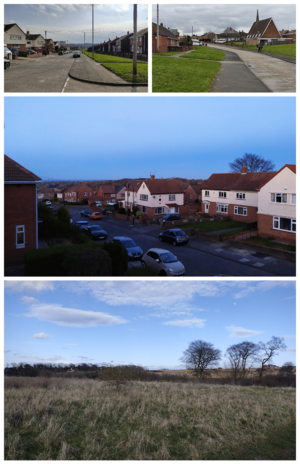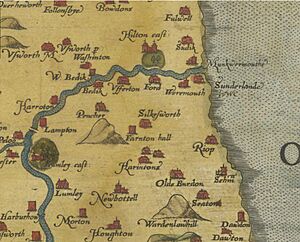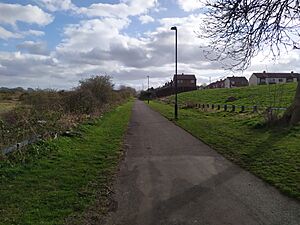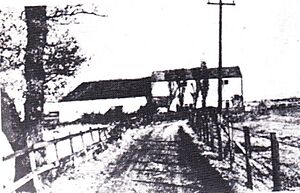Farringdon, Sunderland facts for kids
Quick facts for kids Farringdon |
|
|---|---|
 Pictured from top right clockwise: Arbroath Road, Anthony Road (Former site of Farringdon Hall), Abercorn Road, Farringdon Country Park |
|
| Population | 9,449 (2011 census) (Figure also includes neighbouring East & Middle Herrington as part of the St. Chad's Ward) |
| Metropolitan borough | |
| Metropolitan county | |
| Region | |
| Country | England |
| Sovereign state | United Kingdom |
| Post town | Sunderland |
| Postcode district | SR3 |
| Police | Northumbria |
| Fire | Tyne and Wear |
| Ambulance | North East |
| EU Parliament | North East England |
| UK Parliament |
|
Farringdon is a neighborhood in Sunderland, Tyne and Wear, England. For many years, it was a large farm and estate owned by a monastery. In the 1950s, it was rebuilt as a modern housing area. Farringdon is about 3 miles (4.8 km) south of Sunderland city center. It is near other areas like Thorney Close, Silksworth, East Herrington, Gilley Law, and Doxford Park. The area is part of the St. Chad's ward for local elections.
Contents
Farringdon's Ancient History
Early Human Activity
People have lived in the Farringdon area for a very long time. Evidence of human activity dates back to the Neolithic era, which was the New Stone Age. In the 1950s, during construction work, a stone axe was found. This axe shows that people were living and using tools here thousands of years ago.
Farringdon in the Middle Ages
During the Middle Ages, the area of Farringdon was part of a larger parish called Bishopwearmouth. It was managed as a large farm estate, also known as a Demesne, and was a small village within the township of Silksworth.
The name "Farringdon" comes from an old English phrase meaning "farm or hill of Faer or his sons." Over time, its spelling changed many times. By the 1400s, Farringdon was a "Monastic Grange." This means it was a farm that belonged to the Hexham Priory, a type of monastery.
In the 1420s, a person named Robert Jackson looked after the land. He was also the bailiff of Sunderland, which meant he collected taxes for the Bishop of Durham. By 1479, records show that Farringdon had small houses, a windmill, an oven, and a brewery. A new manor house was built in 1597, but it disappeared by the mid-1900s.
From Renaissance to Modern Times
After the Dissolution of the monasteries (when King Henry VIII closed down monasteries), the Farringdon Monastic Grange became property of the King. Later, Queen Elizabeth I gave the estate to Sir John Forster. The land then passed through several other owners, including the Blakiston and Pepper families.
During the English Civil War, the Scottish Army crossed the River Wear at South Hylton. They set up their main camp at Farringdon Hall.
In the mid-1800s, the Hetton Colliery Railway passed through Farringdon. This was one of the very first railways ever built, and it was used to transport coal. Today, you can walk or cycle along the old railway path, which is now a rail trail.
Farringdon's Modern Housing Estate
The old manor house and farm stayed on the land until the 20th century. In 1950, Sunderland authorities bought a large area of land (about 208 acres or 84 hectares). They planned to build over 1,400 new homes, which created the Farringdon we know today. The last private owners of the estate were not happy with how quickly the land was taken and developed. The local council for Herrington also tried to stop the building plans.
By the end of the 20th century, many of the homes in Farringdon had been bought by the people living in them through a scheme called Right to Buy. In 1998, the Sunderland City Council decided to create Farringdon Country Park. This park is a special place for recreation and nature, located next to the neighborhood.
Education in Farringdon
Farringdon has two schools for young people:
- Farringdon Community Academy: This is a large secondary school for older students. It serves students from Farringdon and nearby areas like Doxford Park, East Herrington, and New Silksworth.
- Farringdon Primary School: This school is for younger children in primary school.
Local Amenities and Shops
Farringdon has several places for residents to use:
- The Dolphin: This is the only pub in Farringdon. It has been voted Sunderland's "pub of the year" for five years in a row!
- Shopping Areas: The neighborhood has three shopping areas. Two are on Allendale Road, and one is on Ashdown Road.
- Supermarkets and Restaurants: You can find a McDonalds and a Simply Local supermarket here. The old Farringdon Hall police station, which closed in 2015, is being turned into a new business park. This new area will have a Greggs, a B&M store, and a Costa Coffee.





